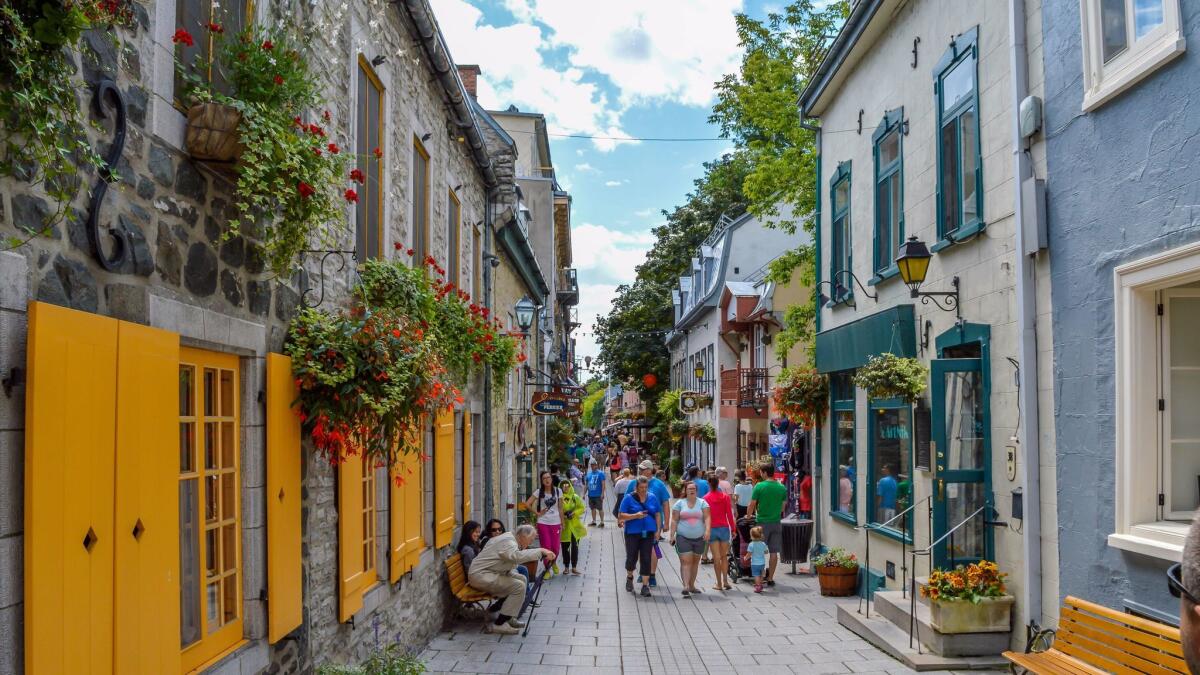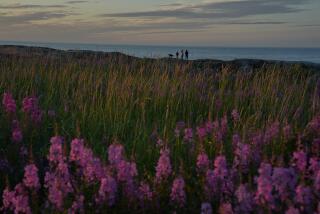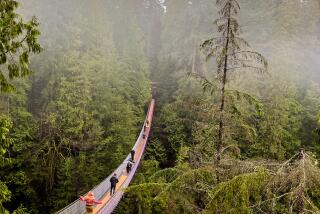Canada is cool, not cold. Its 150th birthday gives you a chance to warm to it as never before
- Share via
Canadians are often stereotyped as unarmed Americans with universal healthcare who dress in heavy winter clothing. Nice and polite, but boring.
We may utter too many “sorrys,” but we are not boring, not the diverse 36 million of us who make Canada unique, and certainly not our 3.8 million square miles of landscapes.
The blend of these merits make Canada not just an ideal travel destination, but — dare I say it because it’s so un-Canadian to boast? — the ideal travel destination.
MORE CANADA: Celebrate Canada’s 150 | Ottawa | Quiz | 150 Canada photos
Sure, we have an identity issue, obvious from the fact that we define ourselves by our subtle but significant differences with our American neighbors.
The United States is a vocal, assertive influencer. We’re more reserved and low key until, of course, we do something like vote in eye-candy Prime Minister Justin Trudeau, who has helped us grab a share of the world’s spotlight.
I didn’t always appreciate my country, not fully anyway, and not until I decided to leave my birthplace — Vancouver, in beautiful British Columbia — in the late ’80s in search of something different.
I spread a world map on the kitchen table and began, for various reasons, eliminating vast regions of the world until all that remained, to my surprise, was Canada.
I packed up and moved to French-flavored Quebec, essentially another country within our own, where I was welcomed into a completely different and distinct European-style culture thriving within our boundaries, a province where some folks don’t speak a word of English and don’t need to.
Globally provincial

That all of us — with each region of the country so vastly different from the next — can live peacefully together (mostly) has made me prouder of Canada than I have ever been.
Our vast, pristine and largely accessible wilderness is as important to me as our vibrant cities, which consistently rate at the top of international charts, thanks to good marks for lifestyle quality, low crime and environmental awareness.
We’re also proud of our cultural diversity. Justin’s father, Pierre Trudeau, enshrined multiculturalism — a term coined in Canada — in our Charter of Rights and Freedoms when he was prime minister.
The U.S. has an immigrant “melting pot” philosophy, but our multiculturalism encourages newcomers to retain their distinct identities.
Partly as a result of that, our cities have dozens of colorful ethnic neighborhoods hosting fabulous festivals, fairs and markets. In 2016, the BBC conducted a survey and found Toronto, with its 230 nationalities, the world’s most culturally diverse city; more than half of the population is foreign born.
All of that adds a magically exotic flavor to our urban centers that make them interesting to visit and darn fun to boot.
Urbane and wild
Our six main regional cities — Vancouver, Calgary, Winnipeg, Toronto, Montreal and Halifax — also boast a vibrant nightlife, hip neighborhoods and innovative cuisine with a strong farm-to-table focus.
Toronto’s fully refurbished downtown Queen’s Quay now includes cycling paths along spectacular Lake Ontario, and cosmopolitan Montreal’s 375th birthday in 2017 means a summer in party mode and even more joie de vivre than usual in the world’s second-biggest Francophone city.
Calgary has the cool new National Music Centre, a “catalyst,” its website says, for “discovery, innovation and renewal through music.”
Vancouver’s mountainside North Shore is the latest neighborhood to become hiply gentrified. Winnipeg is basking in the international attention that its innovative and moving Canadian Museum of Human Rights is getting.
And then there’s Halifax. What can you say about a small, fun, music-loving city that almost eclipses our other metropolises for its number of pubs and clubs per capita and whose most famous brewmaster was also its mayor — three times?
Meanwhile, as always, fiery fiddles will be rocking kitchen parties in rural Newfoundland and the friendly Maritime provinces on the Atlantic Coast — New Brunswick, Nova Scotia and Prince Edward Island. And tables will be set among world-class grapevines in the Niagara region. (It’s not all about those waterfalls.)
The U.S. has an immigrant ‘melting pot’ philosophy, but our multiculturalism encourages newcomers to retain their distinct identities.
Horse-drawn carriages will clatter over cobblestones in walled Quebec City, and gentle, curious beluga whales will be eager to interact with snorkelers in Churchill, Manitoba, where — caution! — legions of polar bears will also be keen to mingle.
Paddle or raft a wild river and sleep under shimmering Northern Lights, meet a roll call of bears and whales along British Columbia’s rain forest coast or head to the Rockies or other mountain ranges to ski, board or hike. (Heli-skiing and heli-hiking are Canadian inventions, by the way.)
Dine on modern First Nations fusion cuisine, which includes contemporary takes on salmon, herring roe, bannock and locally harvested herbs, veggies and fruit you may never have tasted. Stay in traditionally themed hotels, learn to paddle a war canoe or follow a herd of caribou on migration.
Aboriginal tourism, in which visitors take part in indigenous activities and culture, is the fastest-growing sector of Canadian tourism.
Year-round fun
Throughout 2017 and especially this summer, Canada is gearing up to celebrate the 150th anniversary of Confederation, the initial coming together of several Eastern provinces into the “Province of Canada,” and we’re showcasing all we have to offer.
Ottawa is hosting an exciting, full-year calendar of sesquicentennial celebrations. Admission to the country’s 47 national parks, reserves and national historic sites is free throughout the year.
Parks Canada has also made travel to some of its remote northern parks, such as the Torngat Mountains in Labrador, easier with bush plane-accessible summer base camps where you can join and learn from local aboriginals and researchers under the Midnight Sun.
No less an authority than Lonely Planet chose Canada as its No. 1 country to visit in 2017.
Expedia, meanwhile, credits the prime minister for the “crazy-about-Canada” movement. The online travel agency recently released its “Trudeau Travel Effect” stats showing that tourism to Canada is skyrocketing.
More overnight visitors arrived in January — January, as in “winter” — than any time in Canada’s history, and our overseas visitor numbers grew by a whopping 19% from the previous January.
Trudeau’s charm and beau visage aside, we should also credit an exchange rate favorable to travelers, which makes it a bargain and a value.
Americans make up the bulk of our visitors. We’re the good neighbors right on your doorstep, your best friends and your biggest fans. We even made a video recently telling you how we feel about you: “Let’s Tell America It’s Great.”
We may have our own quiet, polite style that’s key to keeping our complex open society from falling apart or crashing into warring tribal factions, but we are not, not, not, never boring.
Rather we are, as David Goldstein, president and chief executive of Destination Canada, has often said, “Cool, not cold.” In fact, we’ll welcome you so warmly you just might find it hard to go home.
@latimestravel
More to Read
Sign up for The Wild
We’ll help you find the best places to hike, bike and run, as well as the perfect silent spots for meditation and yoga.
You may occasionally receive promotional content from the Los Angeles Times.






